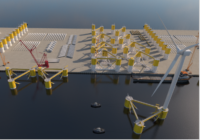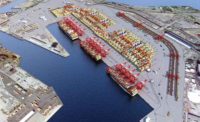From hardening facilities against extreme weather events to reducing emissions, ports are putting to work over $703 million in grants awarded this fall under the federal infrastructure law. Among big winners were California's Port of Long Beach, which received $30.1 million, and the Port of Muskogee in Tulsa, Okla., with $24 million.
The Port of Long Beach, the second largest U.S. seaport, will use the funds to deploy the nation’s largest fleet of manually operated, zero-emissions cargo handling equipment at a single marine terminal. The $37.7-million project will replace diesel yard tractors at the Long Beach Container Terminal with about 60 electric, human-operated yard tractors.

The project for the terminal—which moves more cargo than most U.S. ports annually, at 3.3 million cargo container units—also includes construction of electric equipment charging stations with energy efficiency-enhancing software, training for operators and maintenance personnel and installation of software equipment to streamline cargo-handling operations.
The terminal operator will fund the rest of the project.
“This is a huge step forward to almost completely electrifying the whole container yard operation,” says Heather Tomley, the port's managing director of planning and environmental affairs. “We’ll be installing charging infrastructure to support the operations and providing training for operators.”
Previous grants from California agencies were typically around $5 milion to $10 million for demonstration projects, she notes. “This is a large-scale deployment. We’re fortunate there was this level of [federal] funding.”
The port’s overall goal is to achieve zero emissions by 2030, Tomley adds.
Inland Port Builds a Levee
In 2019, a major flood event along the Arkansas River caused critical damage to Tulsa's Port of Muskogee, leading to a full stop in operations. A portion of the port’s infrastructure law grant will fund a levee project to protect it from any future flood damage, with completion estimated in 2026. Further improvements to be funded include reconstruction of the main dock at Oakley Terminal, as well as the building of a new heavy-lift dock, on-dock rail and flexible-use warehouse.“Flood waters exceeded 30 feet during this historic flooding event,” says Kimbra Scott, port director. “The flood flows were double those of the most recent major flooding event 30 years prior and reached an estimated 675,000 cubic feet per second. Damage to the port included barges breaking loose, as well as damage to downstream river infrastructure. The port ceased operation for four months, which cost the state of Oklahoma daily losses of up to $20.7 million in GDP."
Burns & McDonnell conducted a waterfront infrastructure assessment and Resilience study last year to prioritize needed repairs and replacements, which served as the basis for the successful grant application, she says.





Post a comment to this article
Report Abusive Comment